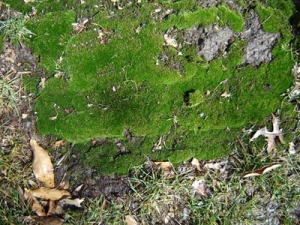Lawn Moss — The Bad News and the Good News
By Elizabeth Cornell Fake, Fairfax Master Gardener
 Lawn moss is one of the peskiest garden weeds showing up at the end of March or the beginning of April. Almost every yard will have its share. For some gardeners, lawn moss is a troublesome problem, and for others it is a welcome sight. Depending on your perspective, lawn moss can be bad news or good news.
Lawn moss is one of the peskiest garden weeds showing up at the end of March or the beginning of April. Almost every yard will have its share. For some gardeners, lawn moss is a troublesome problem, and for others it is a welcome sight. Depending on your perspective, lawn moss can be bad news or good news.
Bad news
You take pride in your beautiful, perfect lawn. But, as spring begins, it looks as if your lawn is being overtaken by a thick green carpet. A subdivision of nonflowering plants called Bryophytes, lawn moss will grow anywhere there is moisture. Once it has grabbed hold, it will grow quickly, edging out struggling turf and extending its presence to nearby rocks, pavers, sidewalks, sides of buildings and roofs.
It is easy to eradicate lawn moss, through either physical or chemical means. Use a metal rake to dethatch the offending patches of moss in your lawn. Rake vigorously to remove it from the surface of the lawn. Dethatch small areas by hand pulling. For larger expanses use a dethatching tool attached to a lawn mower. Spread some grass seed over the raked areas to cover the bare spots.
Some people may want to use a chemical herbicide directly on the moss for complete removal. Use either a glyphosate or an iron sulfate herbicide. For best results, ask for a recommendation at a garden care center. For those interested in organic approaches, a cryptochiral soap mixture kills the moss on contact when applied under dry conditions. Use 4 ounces of dish soap to a gallon of water, gently mixing the solution in a hand spray bottle. Spray at close range to the moss. It will turn orange-brown within 24 hours and dry up, allowing turf to regrow in its place.
The worst of the bad news is that the moss will come back, in spite of your efforts, because of the environmental conditions that allowed it to grow in the first place. These conditions include low sunlight, highly acidic soil, poor drainage, lack of soil nutrients and possibly improper mowing. To improve the habitat for turf and to discourage the lawn moss, try these measures:
- Trim the trees in your yard to introduce more sunlight.
- Have your soil tested through the Virginia Cooperative Extension to determine the soil pH and receive recommendations for pH balancing and fertilizer application. Test kits are available through any public library or at the FCMGA plant clinics.
- Ask a local garden care center for tips on promoting proper drainage.
- Always mow turf to a length of 2 1/2 to 3 inches using a mower with a well-sharpened blade.
Good news
Lawn moss is beautifully green, enduring and highly persistent — all the qualities you want for plants in your garden. If your lawn is a place where lawn moss is flourishing, why not encourage its growth? If you are trying to reduce the amount of turf in your yard, cultivating lawn moss is a good way to cut down on the amount of fertilizing, mowing and weeding you need to do. See last month for information on cultivating moss in your garden, Extolling the Lowly Moss.
References
• Moss in Your Landscape: Friend or Foe, University of Maryland Extension, Home and Garden
Information Center
• How to get rid of moss in your lawn, Oregon State University Extension Service
• Lawn Moss: Friend or Foe, VCE Publication 430-536